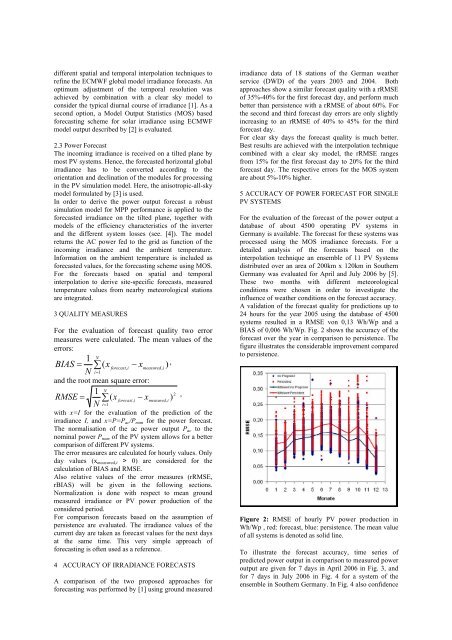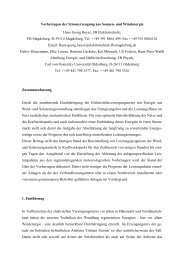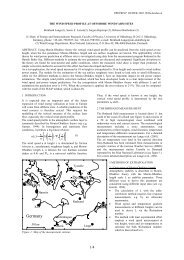forecast of ensemble power production by grid-connected
forecast of ensemble power production by grid-connected
forecast of ensemble power production by grid-connected
Create successful ePaper yourself
Turn your PDF publications into a flip-book with our unique Google optimized e-Paper software.
different spatial and temporal interpolation techniques to<br />
refine the ECMWF global model irradiance <strong>forecast</strong>s. An<br />
optimum adjustment <strong>of</strong> the temporal resolution was<br />
achieved <strong>by</strong> combination with a clear sky model to<br />
consider the typical diurnal course <strong>of</strong> irradiance [1]. As a<br />
second option, a Model Output Statistics (MOS) based<br />
<strong>forecast</strong>ing scheme for solar irradiance using ECMWF<br />
model output described <strong>by</strong> [2] is evaluated.<br />
2.3 Power Forecast<br />
The incoming irradiance is received on a tilted plane <strong>by</strong><br />
most PV systems. Hence, the <strong>forecast</strong>ed horizontal global<br />
irradiance has to be converted according to the<br />
orientation and declination <strong>of</strong> the modules for processing<br />
in the PV simulation model. Here, the anisotropic-all-sky<br />
model formulated <strong>by</strong> [3] is used.<br />
In order to derive the <strong>power</strong> output <strong>forecast</strong> a robust<br />
simulation model for MPP performance is applied to the<br />
<strong>forecast</strong>ed irradiance on the tilted plane, together with<br />
models <strong>of</strong> the efficiency characteristics <strong>of</strong> the inverter<br />
and the different system losses (see. [4]). The model<br />
returns the AC <strong>power</strong> fed to the <strong>grid</strong> as function <strong>of</strong> the<br />
incoming irradiance and the ambient temperature.<br />
Information on the ambient temperature is included as<br />
<strong>forecast</strong>ed values, for the <strong>forecast</strong>ing scheme using MOS.<br />
For the <strong>forecast</strong>s based on spatial and temporal<br />
interpolation to derive site-specific <strong>forecast</strong>s, measured<br />
temperature values from near<strong>by</strong> meteorological stations<br />
are integrated.<br />
3 QUALITY MEASURES<br />
For the evaluation <strong>of</strong> <strong>forecast</strong> quality two error<br />
measures were calculated. The mean values <strong>of</strong> the<br />
errors:<br />
1 N<br />
BIAS = ∑ ( x <strong>forecast</strong> i − x<br />
N i=<br />
1<br />
, measured,<br />
i<br />
and the root mean square error:<br />
1 N<br />
2<br />
RMSE = ( x − x ) ,<br />
∑ <strong>forecast</strong>,<br />
i measured,<br />
i<br />
N i=<br />
1<br />
with x=I for the evaluation <strong>of</strong> the prediction <strong>of</strong> the<br />
irradiance I, and x=P=Pac/Pnom for the <strong>power</strong> <strong>forecast</strong>.<br />
The normalisation <strong>of</strong> the ac <strong>power</strong> output Pac to the<br />
nominal <strong>power</strong> Pnom <strong>of</strong> the PV system allows for a better<br />
comparison <strong>of</strong> different PV systems.<br />
The error measures are calculated for hourly values. Only<br />
day values (xmeasured,i > 0) are considered for the<br />
calculation <strong>of</strong> BIAS and RMSE.<br />
Also relative values <strong>of</strong> the error measures (rRMSE,<br />
rBIAS) will be given in the following sections.<br />
Normalization is done with respect to mean ground<br />
measured irradiance or PV <strong>power</strong> <strong>production</strong> <strong>of</strong> the<br />
considered period.<br />
For comparison <strong>forecast</strong>s based on the assumption <strong>of</strong><br />
persistence are evaluated. The irradiance values <strong>of</strong> the<br />
current day are taken as <strong>forecast</strong> values for the next days<br />
at the same time. This very simple approach <strong>of</strong><br />
<strong>forecast</strong>ing is <strong>of</strong>ten used as a reference.<br />
4 ACCURACY OF IRRADIANCE FORECASTS<br />
A comparison <strong>of</strong> the two proposed approaches for<br />
<strong>forecast</strong>ing was performed <strong>by</strong> [1] using ground measured<br />
)<br />
,<br />
irradiance data <strong>of</strong> 18 stations <strong>of</strong> the German weather<br />
service (DWD) <strong>of</strong> the years 2003 and 2004. Both<br />
approaches show a similar <strong>forecast</strong> quality with a rRMSE<br />
<strong>of</strong> 35%-40% for the first <strong>forecast</strong> day, and perform much<br />
better than persistence with a rRMSE <strong>of</strong> about 60%. For<br />
the second and third <strong>forecast</strong> day errors are only slightly<br />
increasing to an rRMSE <strong>of</strong> 40% to 45% for the third<br />
<strong>forecast</strong> day.<br />
For clear sky days the <strong>forecast</strong> quality is much better.<br />
Best results are achieved with the interpolation technique<br />
combined with a clear sky model, the rRMSE ranges<br />
from 15% for the first <strong>forecast</strong> day to 20% for the third<br />
<strong>forecast</strong> day. The respective errors for the MOS system<br />
are about 5%-10% higher.<br />
5 ACCURACY OF POWER FORECAST FOR SINGLE<br />
PV SYSTEMS<br />
For the evaluation <strong>of</strong> the <strong>forecast</strong> <strong>of</strong> the <strong>power</strong> output a<br />
database <strong>of</strong> about 4500 operating PV systems in<br />
Germany is available. The <strong>forecast</strong> for these systems was<br />
processed using the MOS irradiance <strong>forecast</strong>s. For a<br />
detailed analysis <strong>of</strong> the <strong>forecast</strong>s based on the<br />
interpolation technique an <strong>ensemble</strong> <strong>of</strong> 11 PV Systems<br />
distributed over an area <strong>of</strong> 200km x 120km in Southern<br />
Germany was evaluated for April and July 2006 <strong>by</strong> [5].<br />
These two months with different meteorological<br />
conditions were chosen in order to investigate the<br />
influence <strong>of</strong> weather conditions on the <strong>forecast</strong> accuracy.<br />
A validation <strong>of</strong> the <strong>forecast</strong> quality for predictions up to<br />
24 hours for the year 2005 using the database <strong>of</strong> 4500<br />
systems resulted in a RMSE von 0,13 Wh/Wp and a<br />
BIAS <strong>of</strong> 0,006 Wh/Wp. Fig. 2 shows the accuracy <strong>of</strong> the<br />
<strong>forecast</strong> over the year in comparison to persistence. The<br />
figure illustrates the considerable improvement compared<br />
to persistence.<br />
Figure 2: RMSE <strong>of</strong> hourly PV <strong>power</strong> <strong>production</strong> in<br />
Wh/Wp , red: <strong>forecast</strong>, blue: persistence. The mean value<br />
<strong>of</strong> all systems is denoted as solid line.<br />
To illustrate the <strong>forecast</strong> accuracy, time series <strong>of</strong><br />
predicted <strong>power</strong> output in comparison to measured <strong>power</strong><br />
output are given for 7 days in April 2006 in Fig. 3, and<br />
for 7 days in July 2006 in Fig. 4 for a system <strong>of</strong> the<br />
<strong>ensemble</strong> in Southern Germany. In Fig. 4 also confidence








